Surfing
This article needs additional citations for verification. (April 2010) |

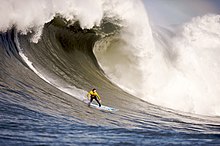
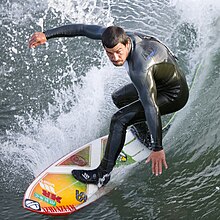
Surfing is a surface water sport in which the surfer rides a surfboard on the crest and face of a wave, which is carrying the surfer towards the shore. Waves suitable for surfing are found primarily in the ocean, but are also sometimes found in lakes and rivers, and also in manmade wave pools.
Many variations of the sport may exist in certain areas
and the definitions of what constitutes a suitable wave, and craft has expanded over the years. Bodysurfing involves riding the wave without a board, and is considered by some to be the purest form of surfing. Other variations that have existed for centuries include paipo boarding, stand up paddle surfing, and the use of boats or canoes to ride waves. More modern craft that are used include bodyboards, inflatable mats (surfmatting), and foils. As documented in various surfing documentaries (including "Fair Bits") other objects have occasionally been used instead of surfboards, including water skiis, wakeboards, desks, guitars, and doors. When more than one person uses the same craft to ride a wave together, it is known as "tandem" surfing.
Three major subdivisions within stand-up surfing are longboarding, shortboarding, and stand up paddle surfing (SUP), reflecting differences in board design, including surfboard length, riding style, and the kind of wave that is ridden.
In tow-in surfing (most often, but not exclusively, associated with big wave surfing), a motorized water vehicle, such as a personal watercraft, tows the surfer into the wave front, helping the surfer match a large wave's higher speed, which is generally a speed that a self-propelled surfer cannot match.
Surfing-related sports such as paddleboarding and sea kayaking do not require waves, and other derivative sports such as kitesurfing and windsurfing rely primarily on wind for power, yet all of these platforms may also be used to ride waves.
Recently with the use of V-drive boats, wake surfing, in which one surfs on the wake of a boat, has emerged.
Polynesia
For centuries surfing was a central part of ancient Polynesian culture. Surfing might have been first observed by Europeans at Tahiti in 1767 by Samuel Wallis and the crew members of the Dolphin who were the first Europeans to visit the island in June 1767. Another candidate is the botanist Joseph Banks[1] being part of the First voyage of James Cook on the HMS Endeavour, who arrived on 10 April 1769 on Tahiti. Lieutenant James King was the first one who wrote about the art of surfing on Hawaii when completing the journals of Captain James Cook upon Cook's death in 1779.
When Mark Twain visited Hawaii in 1866 he wrote,
- "In one place we came upon a large company of naked natives, of both sexes and all ages, amusing themselves with the national pastime of surf-bathing."[2]
References to surf riding on planks and single canoe hulls are also verified for pre-contact Samoa, where surfing was called fa'ase'e or se'egalu (see Kramer, Samoa Islands) and Tonga far pre-dating the practice of surfing by Hawaiians and eastern Polynesians by over a thousand years.
The man known as "The Pioneer of Modern Surfing" is the Hawaiian Duke Kahanamoku, who was a Gold medal winning Olympic swimmer who brought surfing into the public consciousness in the form it is currently known.
Surf waves


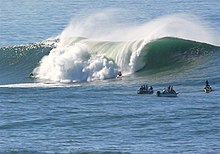
Swell is generated when wind blows consistently over a large area of open water, called the wind's fetch. The size of a swell is determined by the strength of the wind and the length of its fetch and duration. Because of this, surf tends to be larger and more prevalent on coastlines exposed to large expanses of ocean traversed by intense low pressure systems.
Local wind conditions affect wave quality, since the surface of a wave can become choppy in blustery conditions. Ideal conditions include a light to moderate "offshore" wind, because it blows into the front of the wave, making it a "barrel" or "tube" wave. Waves are Left handed and Right Handed.
The most important influence on wave shape is the topography of the seabed directly behind and immediately beneath the breaking wave. The contours of the reef or bar front becomes stretched by diffraction. Each break is different, since each location's underwater topography is unique. At beach breaks, sandbanks change shape from week to week. Surf forecasting is aided by advances in information technology. Mathematical modeling graphically depicts the size and direction of swells around the globe.
Swell regularity varies across the globe and throughout the year. During winter, heavy swells are generated in the mid-latitudes, when the North and South polar fronts shift toward the Equator. The predominantly Westerly winds generate swells that advance Eastward, so waves tend to be largest on West coasts during winter months. However, an endless train of mid-latitude cyclones cause the isobars to become undulated, redirecting swells at regular intervals toward the tropics.
East coasts also receive heavy winter swells when low-pressure cells form in the sub-tropics, where slow moving highs inhibit their movement. These lows produce a shorter fetch than polar fronts, however they can still generate heavy swells, since their slower movement increases the duration of a particular wind direction. The variables of fetch and duration both influence how long wind acts over a wave as it travels, since a wave reaching the end of a fetch behaves as if the wind died.
During summer, heavy swells are generated when cyclones form in the tropics. Tropical cyclones form over warm seas, so their occurrence is influenced by El Niño & La Niña cycles. Their movements are unpredictable. They can move Westward as in 1979, when Tropical Cyclone Kerry wandered for three weeks across the Coral Sea and into Queensland before dissipating.
Surf travel and some surf camps offer surfers access to remote, tropical locations, where tradewinds ensure offshore conditions. Since winter swells are generated by mid-latitude cyclones, their regularity coincides with the passage of these lows. Swells arrive in pulses, each lasting for a couple of days, with a few days between each swell.
The availability of free model data from the NOAA has allowed the creation of several surf forecasting websites.
Wave intensity

Classification parameters
- Tube shape defined by length to width ratio
- Square: <1:1
- Round: 1-2:1
- Almond: >2:1
- Tube speed defined by angle of peel line
- Fast: 30°
- Medium: 45°
- Slow: 60°
| Fast | Medium | Slow | |
|---|---|---|---|
| Square | The Cobra | Teahupoo | Shark Island |
| Round | Speedies, Gnaraloo | Banzai Pipeline | |
| Almond | Lagundri Bay, Superbank | Jeffreys Bay, Bells Beach | Angourie Point |
Artificial reefs
The value of good surf in attracting surf tourism has prompted the construction of artificial reefs and sand bars. Artificial surfing reefs can be built with durable sandbags or concrete, and resemble a submerged breakwater. These artificial reefs not only provide a surfing location, but also dissipate wave energy and shelter the coastline from erosion. Ships such as Seli 1 that have accidentally stranded on sandy bottoms, can create sandbanks that give rise to good waves.[3]
An artificial reef known as Chevron Reef, was constructed in El Segundo, California in hopes of creating a new surfing area. Howevever the reef failed to produce any quality waves and was removed in 2008. In Kovalam, South West India, an artificial reef has however successfully provided the local community with a quality lefthander, stabilized coastal soil erosion, and provided good habitat for marine life.[4] ASR Ltd., a New Zealand based company, constructed the Kovalam reef and is working on another reef in Boscombe, England.
Even with artificial reefs in place, a tourist's vacation time can sometimes coincide with a "flat spell", such that there are no waves available. Completely artificial Wave pools aim to solve that problem by controlling all the elements that go into creating perfect surf, however there are only a handful of wave pools that can simulate good surfing waves, owing primarily to construction and operation costs and potential liability. Most wave pools generate waves that are too small and lack the proper power to actually surf. The Seagaia Ocean Dome, located in Miyazaki, Japan, was an example of a surfable wave pool. Able to generate waves with up to 10 foot faces, the specialized pump held water in 20 vertical tanks positioned along the back edge of the pool. This allowed the waves to be directed as they approach the artificial sea floor. Lefts, Rights, and A-frames could be directed from this pump design providing for rippable surf and barrel rides. The Ocean Dome cost about $2 billion to build and was expensive to maintain.[5] The Ocean Dome was closed in 2007.
Surfers and surf culture
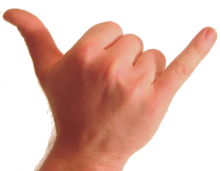
Surfers represent a diverse culture based on riding the waves. Some people practice surfing as a recreational activity while others make it the central focus of their lives. Within the United States, surfing culture is most dominant in Hawaii and California because these two states offer the best surfing conditions. However, waves can be found wherever there is coastline, and a tight-knit yet far-reaching subculture of surfers has emerged throughout America. Some historical markers of the culture included the woodie, the station wagon used to carry surfers' boards, as well as boardshorts, the long swim shorts typically worn while surfing.
The sport of surfing now represents a multi-billion dollar industry especially in clothing and fashion markets. The Association of Surfing Professionals (ASP) runs the world tour, hosting only the best competitors in some of the best surf spots around the globe. Other people make a career out of surfing by receiving corporate sponsorships and performing for photographers and videographers in far-flung destinations; they are typically referred to as freesurfers.
When the waves were flat, surfers persevered with sidewalk surfing, which is now called skateboarding. Sidewalk surfing has a similar feel to surfing and requires only a paved road or sidewalk. To create the feel of the wave, surfers even sneak into empty backyard swimming pools to ride in, known as pool skating. Eventually, surfing made its way to the slopes with the invention of the Snurfer, later credited as the first snowboard. Many other board sports have been invented over the years, but all can trace their heritage back to surfing.
Maneuvers

Surfing begins when the surfer paddles toward shore in an attempt to match the speed of the wave. Once the wave begins to carry the surfer forward, the surfer stands up and proceeds to ride the wave. The basic idea is to position the surfboard so it is just ahead of the breaking part (white water) of the wave. A common problem for beginners is being able to catch the wave at all.
A surfer is respected if he catches a wave in the middle and maneuvers his way to the shoulder (or edge) of the breaking wave. Conversely, a surfer who takes off on the shoulder often becomes an obstacle for more skilled surfers taking off in the 'impact zone' and is deemed a shoulder hopper. Surfers' skills are tested by their ability to control their board in challenging conditions, riding challenging waves, and executing maneuvers such as strong turns and cutbacks (turning board back to the breaking wave) and carving (a series of strong back-to-back maneuvers). More advanced skills include the floater (riding on top of the breaking curl of the wave), and off the lip (banking off the breaking wave). A newer addition to surfing is the progression of the air whereby a surfer propels off the wave entirely and re-enters the wave.
The tube ride is considered to be the ultimate maneuver in surfing. As a wave breaks, if the conditions are ideal, the wave will break in an orderly line from the middle to the shoulder, enabling the experienced surfer to position him / her self actually inside the wave as it is breaking. This is known as a tube ride. If you are watching from shore, the tube rider may disappear from view as the wave breaks over the rider's head. If the surfer succeeds in bulleting out of the tube, it was a great ride. The longer the surfer remains in the tube, the more successful the ride. Some of the world's best known waves for tube riding include Pipeline on the North shore of Oahu, Teahupoo in Tahiti and G-Land in Java. Other names for the tube include "the barrel", and "the curl".
When a surfer gets a tube ride, it is often referred to as getting tubed or getting barreled.
Hanging ten and Hanging five are moves usually specific to long boarding and is considered [6] one of the most impressive and iconic stunts one can perform. Hanging Ten refers to having both feet on the front end of the board with all of the surfer's toes off the edge, also known as [nose-riding]. Hanging Five is having just one foot near the front, with five toes off the edge.
Cutback: Generating speed down the line and then turning back to reverse direction.
Floater: Suspending the board atop the wave. Very popular on small waves.
Top-Turn: Turn off the top of the wave. Sometimes used to generate speed and sometimes to shoot spray.
Air / Aerial: Launching the board off the wave entirely, then re-entering the wave. Various airs include ollies, lien airs, method airs, and other skateboard-like maneuvers.
Surfing terms
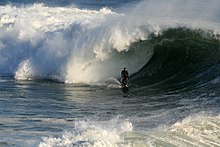
Learning to surf
Many popular surfing destinations have surf schools and surf camps that offer lessons. Surf camps for beginners and intermediates are multi-day lessons that focus on surfing fundamentals. They are designed to take new surfers and help them become proficient riders. All-inclusive surf camps offer overnight accommodations, meals, lessons and surfboards. Most surf lessons begin by instructors pushing students into waves on longboards. The longboard is considered the ideal surfboard for learning, due to the fact it has more paddling speed and stability than shorter boards. Funboards are also a popular shape for beginners as they combine the volume and stability of the longboard with the manageable size of a smaller surfboard.[7]
Typical surfing instruction is best performed one-on-one, but can also be done in a group setting. Popular surf locations offer perfect surfing conditions for beginners, as well as challenging breaks for advanced students. Surf spots more conducive to instruction typically offer conditions suitable for learning, most importantly, sand bars or sandy bottom breaks with consistent waves.
Surfing can be broken into several skills: drop in positioning to catch the wave, the pop-up, and positioning on the wave. Paddling out requires strength but also the mastery of techniques to break through oncoming waves (duck diving, eskimo roll). Drop in positioning requires experience at predicting the wave set and where they will break. The surfer must pop up quickly as soon as the wave starts pushing the board forward. Preferred positioning on the wave is determined by experience at reading wave features including where the wave is breaking.[8]
Balance plays a crucial role in standing on a surfboard. Thus, balance training exercises are a good preparation. Practicing with a Balance board or swing boarding helps novices master the art.
Equipment

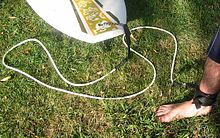

Surfing can be done on various equipment, including surfboards, longboards, Stand Up Paddle boards (SUP's), bodyboards, wave skis, skimboards, kneeboards, surf mats and macca's trays.
Surfboards were originally made of solid wood and were large and heavy (often up to 12 ft or 3.7 m long and 150 lb or 68 kg). Lighter balsa wood surfboards (first made in the late 1940s and early 1950s) were a significant improvement, not only in portability, but also in increasing maneuverability.
Most modern surfboards are made of polyurethane foam (PU), with one or more wooden strips or "stringers", fiberglass cloth, and polyester resin (PE). An emerging board material is epoxy resin and Expanded PolyStyrene foam (EPS) which is stronger and lighter than traditional PU/PE construction. Even newer designs incorporate materials such as carbon fiber and variable-flex composites in conjunction with fiberglass and epoxy or polyester resins.
Since epoxy/EPS surfboards are generally lighter, they will float better than a traditional PU/PE board of similar size, shape and thickness. This makes them easier to paddle and faster in the water. However, a common complaint of EPS boards is that they do not provide as much feedback as a traditional PU/PE board. For this reason, many advanced surfers prefer that their surfboards be made from traditional materials.
Other equipment includes a leash (to stop the board from drifting away after a wipeout, and to prevent it from hitting other surfers), surf wax, traction pads (to keep a surfer's feet from slipping off the deck of the board), and fins (also known as skegs) which can either be permanently attached (glassed-on) or interchangeable.
Sportswear designed or particularly suitable for surfing may be sold as boardwear (the term is also used in snowboarding). In warmer climates, swimsuits, surf trunks or boardshorts are worn, and occasionally rash guards; in cold water surfers can opt to wear wetsuits, boots, hoods, and gloves to protect them against lower water temperatures. A newer introduction is a rash vest with a thin layer of titanium to provide maximum warmth without compromising mobility.
There are many different surfboard sizes, shapes, and designs in use today. Modern longboards, generally 9 to 10 feet (3.0 m) in length, are reminiscent of the earliest surfboards, but now benefit from modern innovations in surfboard shaping and fin design. Competitive longboard surfers need to be competent at traditional walking maneuvers, as well as the short-radius turns normally associated with shortboard surfing.
The modern shortboard began life in the late 1960s and has evolved into today's common thruster style, defined by its three fins, usually around 6 to 7 feet (1.8 to 2.1 m) in length. The thruster was invented by Australian shaper Simon Anderson.
Midsize boards, often called funboards, provide more maneuverability than a longboard, with more floation than a shortboard. While many surfers find that funboards live up to their name, providing the best of both surfing modes, others are critical.
- "It is the happy medium of mediocrity," writes Steven Kotler. "Funboard riders either have nothing left to prove or lack the skills to prove anything."[9]
There are also various niche styles, such as the Egg, a longboard-style short board targeted for people who want to ride a shortboard but need more paddle power. The Fish, a board which is typically shorter, flatter, and wider than a normal shortboard, often with a split tail (known as a swallow tail). The Fish often has two or four fins and is specifically designed for surfing smaller waves. For big waves there is the Gun, a long, thick board with a pointed nose and tail (known as a pin tail) specifically designed for big waves.
Famous surfing locations
Arugam Bay, Ullae (Pottuvil, Sri Lanka)
A small fishing village up to recently only known to some die hard surfers. For which AbaY counted as Asia's Surfing Mecca, ever since the 1960s. Due to Sri Lanka's long civil war this remote half moon shaped Bay has been almost unknown to any other visitors and tourists. The consistent swell, long runs, shark free, permanently warm (28C) crystal clear waters, relaxed life onshore and budget accommodation however has elevated Arugam Bay onto the international surfer's map. In June 2010 ASP (Association of Surfing Professionals) held a successful international competition at A-Bay – as it's known – which was won by Australian Julian Wilson. [1]. Arugam Bay is often mentioned to be in the top 10 of the world's surf spots, due to a basket of favorable factors. The average wave height however rarely exceeds 3–4 Meters. Most of the resort was wiped off in the 2004 Tsunami when AbaY suffered a direct hit by a 16–18 Meter wave, caused by its long coral reef located at the Main Surf Point also known as "Upali's" point. Other known surf breaks nearby are Pottuvil Point, Whisky Point, Okanda Bay, Panama, Green Room, Urani. "Arugam Surf" is Sri Lanka's first and rather remarkable, popular Facebook page with 27,000 fans giving almost daily updates of relevant events from the Bay itself.
Bells Beach (Victoria, Australia)
Although the final scene of the film Point Break is set at Bells Beach, the scene was not filmed there. Bells Beach is a straight stretch and the beach in the film is a cove with spruce trees atop a hill. The actual location of the film was a beach called Indian Beach, in Ecola State Park, located in Cannon Beach, Oregon, USA. Bells Beach is visited in the 1966 documentary film The Endless Summer.
Bells Beach is the home of the world's longest-running surfing competition – the Rip Curl Pro Surf & Music Festival. The event was formerly known as the Bells Beach Surf Classic. The competition was first held in January 1961 and then at Easter every year since although occasionally, when conditions at Bells aren't suitable, the competition has been transferred to other breaks such as Johanna.
As early as 1939 surfers from Torquay made their way to Bells but access was a considerable problem until 1960 when Torquay surfers and Olympic wrestler Joe Sweeney hired a bulldozer and cleared a road along the Bells cliff [1] from the Cobb & Co Road, where the concrete wave now stands, down to the beach. He charged one pound per surfer to recover his expenses. This is now part of the Torquay to Anglesea walking track.
Nearby surf breaks include "Southside", "Centreside", "Rincon", "Winki Pop", (Uppers and Lowers), Boobs and Steps. Although Bells is known internationally as one of the best breaks in Victoria, "Winki Pop" often works better under more diverse conditions than the other nearby breaks.[citation needed]
In 1988 a group of local surfers who were concerned about the human impact that tourism was having on the Bells Beach Surfing Reserve started a group called Surfers Appreciating the Natural Environment. Since 1988 they have met monthly to revegetate the reserve in an effort to bring it back to its original state. They have planted over 100,000 plants there to date.
Jeffreys Bay (Eastern Cape, South Africa)
The break is regarded as one of the best right-hand point breaks in the entire world, in both consistency and quality, in season. It has been divided up into several sections, including, from the top of the point, Kitchen Windows, Magna tubes, Boneyards, Supertubes, Impossibles, Tubes, the Point, and Albatross. "Supertubes", which itself breaks for about 300m or more, is regarded as the best part of the wave. On rare occasions (large wave sizes, wide-breaking waves, and even swells), Boneyards can link up all the way to the Point for a ride over one kilometer long. The most consistent waves occur between about May to mid September, also often coinciding with offshore winds, although good waves can occasionally occur at other times of the year.[citation needed]
The initial discovery and promotion of the wave is curious. Another nearby right hand point wave at St. Francis Bay (Bruce's Beauty) was first idolised and promoted in the cult classic surf movie The Endless Summer in the 1960s (although both Jeffreys Bay and St. Francis Bay were probably surfed much earlier). Surfers who travelled to the area soon stumbled upon the nearby Jeffreys Bay surf break, which was found to be not only a faster, more powerful, and hollower wave, but also much more consistent.
La Libertad (El Salvador, Central America)

El Puerto is home to one of the best right points in Central America, known for its fast hollow, pulsing, over 30-second ride waves. Punta Roca (also called "La Punta" by local surfers) has been the perfect spot for many known surfers who back in the 1970s discovered the point with only a few local surfers brave enough to venture into its rocky bottom plane. It is known that legend Gerry Lopez, travelled frequently to this surf spot back in the 1970s encouraging a new wave of locals to get into the sport. By the 1980s, El Salvador went through a civil war, and getting to the point was rather dangerous slowing visitors, and with that, a scarcity of surf boards to the locals whose only means of getting a surf board was by travelers leaving them behind in exchange of guidance and accommodations. Local legend, "Yepi" was one the first of his generation to take on full self-support and help maintain the sport, a popular activity among locals. Locals have also been increasing the popularity of the sport throughout the country by offering custom surf tours to tourists and visitors in the region.
The main wave extends from La Punta to the township, a distance of about 800m, although single rides do not normally connect along this whole distance. On a good 6 to 8 feet day (Hawaiian scale), the top part of the point produces the best waves, giving a ride of about 300m or more. The wave features a relatively easy takeoff with long, fast, powerful walls, with longer hollow barrels on the best days. This wave works from about 3 to 12 feet (Hawaiian scale), and can barrel anywhere along the point, but most often closest to the takeoff area. The main takeoff is close to a dangerous rock which often sticks out of the water, and has caused injuries. It works on all tides, although low tide probably has more barrels. The wave is unusual in that it often breaks at a slight angle to the shoreline, hitting it slightly squarely, creating powerful and fast walls. It can be difficult to get out the back in large swells, and the rocky shoreline is notorious for its rather difficult entry.
Further down the point are a few other breaks, including next to the cemetery and in the town itself. These are less crowded and can produce waist-high waves on occasions, but the world-class section of the point is way on the outside.
Other surf spots around the region include: Conchalio, La Paz, San Diego, EL Zunzal, La Bocana, El Zonte
Mavericks (California, U.S.A.)

Maverick's or Mavericks is a world-famous surfing location in Northern California. It is located approximately one-half mile (0.8 km) from shore in Pillar Point Harbor, just North of Half Moon Bay at the village of Princeton-By-The-Sea. After a strong winter storm in the Northern Pacific Ocean, waves can routinely crest at over 25 feet (8m) and top out at over 50 feet (15m). The break is caused by an unusually-shaped underwater rock formation.
Pipeline (Oahu, Hawaii)
Pipeline is a surf reef break located in Hawaii, off Ehukai Beach Park in Pupukea on O'ahu's North Shore. The spot is notorious and famous for its huge waves breaking in shallow water just above its sharp and cavernous reef, forming large, hollow and thick curls of water that surfers can ride inside of. There are three reefs at Pipeline in progressively deeper water further out to sea that activate at various power levels applied by ocean swells.
Teahupoʻo (Tahiti)
Teahupoʻo (pronounced cho-po) is a world-renowned surfing location off the South West of the island of Tahiti, French Polynesia, southern Pacific Ocean. It is known for its heavy, glassy waves, often reaching 2 to 3 m (7 to 10 ft) and higher. It is the site of the annual Billabong Pro Tahiti surf competition, part of the World Championship Tour (WCT) of the ASP World Tour professional surfing circuit.
Zicatela Beach (Mexican Pipeline)
Zicatela is a beach located in the town of Puerto Escondido, Oaxaca. Nicknamed the "Mexican Pipeline" due to the similar power and shape of the Banzai Pipeline on the North Shore of Oahu, the wave that breaks on Zicatela Beach draws an international crowd of surfers, bodyboarders and their entourages. Mid to late summer is low season for tourists, but a prime time for waves and international tournaments. A number of international competitions such as the ESPN X Games, and the MexPipe Challenge have taken place.
Costa da Caparica (Almada, Portugal)

Caparica Beaches are popular Atlantic beaches located on Portugal's Almada coast, near Lisbon. The Caparica Coast, with part of the Protected Landscape of the Ancient Beach of Costa da Caparica, is visible the Convent of the Capuchos. The beach has preferred surfing conditions and is also popular for windsurfing, and kitesurfing. The International Surf Center is based in Caparica.
Supertubos (Peniche, Portugal)
The little fishing town of Peniche it’s probably the most renowned surfing area in the country. Originally an island, Peniche became one with the mainland due to the silting up of the shallow channel that divided it from the rest of the country. Today that short and narrow spit of land contains an obscene amount of wave variety that can provide the goods in almost any conditions. Most famous is Supertubos, regarded by many as one of Europe’s best beach breaks, but there are plenty of other barrels to pull into around Peniche. Peniche is a year round destination with swell exposure on the north side of the town and shelter on the south. The town also sits at the dividing point between the cooler and wetter north and the dry, sunny south meaning that summers are long but tempered by cool sea breezes and the winters mild though occasionally stormy. Supertubos is considered the best wave in Portugal and one of the best in Europe. It is a fast and tubular wave which breaks on a hollow sand bank. It works best with SW swells and N, NE or NW winds. Andy Irons, Kelly Slater and Mick Fanning made frequent appearances in the Supertubos surf competitions. Know the local Surfers
Dangers
Drowning
Surfing, like all water sports, carries the inherent danger of drowning. (Anyone at any age can learn to surf, but must have at least intermediate swimming skills.) Although the board assists a surfer in staying buoyant, it cannot be relied on for floation if it becomes separated from the user.[10] The leash, which is attached at the ankle, keeps the surfer connected to the board for convenience but does not prevent drowning. Surfers should be careful to remain in smaller surf until they've acquired the advanced skills necessary to handle bigger waves and challenging conditions.
Top surfers have drowned in extremely challenging conditions. Some drownings occurred as a result of leashes tangling with reefs, holding the surfer underwater. In very large waves such as Waimea or Mavericks, a leash may be undesirable, because the water can drag the board for long distances, holding the surfer underneath the wave.
Collisions

Under the wrong set of conditions, anything that a surfer's body can come in contact with is potentially a danger, including sand bars, rocks, reefs, surfboards, and other surfers.[11] Collisions with these objects can sometimes cause injuries such as cuts and scrapes and in rare instances, death.
A large number of injuries, up to 66%,[12] are caused by collision with a surfboard (nose or fins). Fins can cause deep lacerations and cuts, as well as bruising. While these injuries can be minor, they can open the skin to infection from the sea; groups like Surfers Against Sewage campaign for cleaner waters to reduce the risk of infections. Local bugs and disease can be a dangerous factor when surfing around the globe.[13]
Falling off a surfboard or colliding with others, is commonly referred to as a wipeout.
Marine life
Sea life can sometimes cause injuries and even fatalities. Animals such as sharks,[14] stingrays, Weever fish, seals and jellyfish can sometimes present a danger.[15] Surfers do the "Stingray Shuffle," where they shuffle their feet in the sand as they head out to catch waves to scare away the stingrays that may be relaxing in the warm, shallow water.[16]
Rip currents
Rip currents can endanger both experienced and inexperienced surfers. Rip currents are water channels that flow away from the shore. Since these currents lurk in seemingly calm waters, tired or inexperienced swimmers or surfers can be swept away. A rip current can have a width of up to forty or fifty feet. However, by paddling parallel to the shore, a surfer can easily escape the rip current. Alternatively, surfers use rips to help them get out to waves.[17]
Seabed
The seabed can pose dangers for surfers. If a surfer falls while riding a wave, the wave will then toss him around, usually downwards. At reef breaks and beach breaks, surfers have been seriously injured or even killed because of a violent collision with the sea bed, the water above which can sometimes be very shallow, especially on beach breaks during low tide. Cyclops, Western Australia, for example is one of the biggest and thickest reef breaks in the world, with waves measuring up to 10 metres high, and yet the reef below is only about 2 meters (6 feet) below the surface of the water.
See also
|
References
- ^ Fleming, F. (2005?) Off the Map. Tales of Endurance and Exploration, p. 154. Atlantic Monthly Press.
- ^ Roughing It by Mark Twain
- ^ Seli 1: One Year On : ZIGZAG – Surfing Magazine | South African Surfing forecasts, news, photos and videos
- ^ first artificial reef to protect Kovalam
- ^ Surfline.com
- ^ http://www.urbandictionary.com/define.php?term=hanging%20ten
- ^ John Dang. "Learn To Surf". surfscience.com. Retrieved 2010-03-11.
{{cite web}}: Italic or bold markup not allowed in:|publisher=(help) - ^ The quick guide on how to surf
- ^ Kotler, Steven (June 13, 2006). West of Jesus: Surfing, Science, and the Origins of Belief. Bloomsbury. ISBN 1596910518.
- ^ Ocean Safety
- ^ Hard Bottom Surf Dangers
- ^ The Dangers of Surfing
- ^ Andy Irons dies from Dengue Fever
- ^ "Unprovoked White Shark Attacks on Surfers". Shark Research Committee. Retrieved 20 September 2010.
- ^ "Surf Dangers Animals".
- ^ Doing the 'Stingray Shuffle' – ABC News
- ^ "Surfing's hidden dangers". BBC News. September 7, 2001. Retrieved May 24, 2010.
